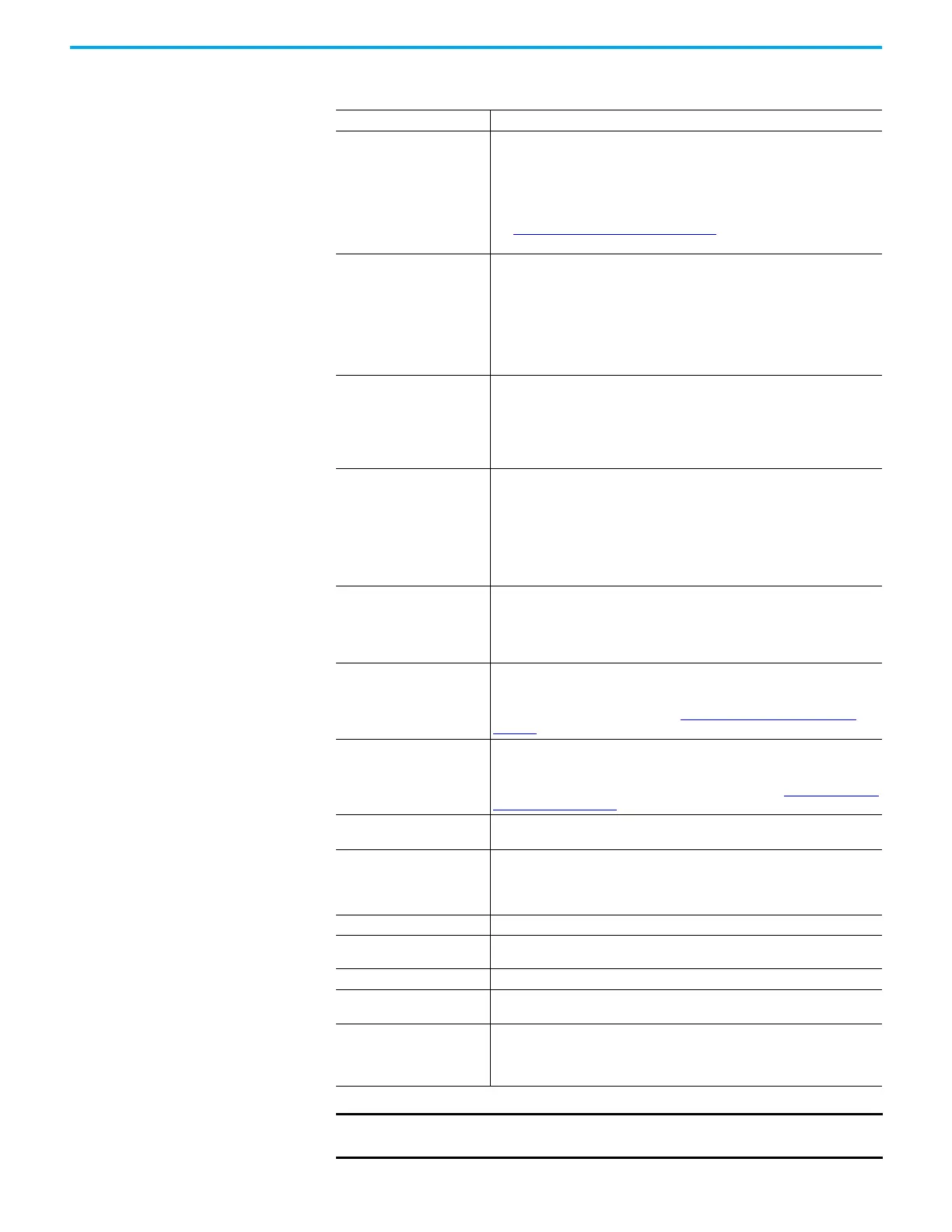Rockwell Automation Publication 2080-UM002N-EN-E - November 2022 341
Appendix G Connect to Networks using DF1
Control Line
This parameter defines the mode in which the driver operates. Choose a method
appropriate for your system’s configuration:
• If you are not using a modem, choose NO HANDSHAKE.
• If the master modem is full duplex, choose FULL-DUPLEX (RTS ALWAYS ON).
• If all the modems in the system are half-duplex, choose HALF-DUPLEX WITHOUT
CONTINUOUS CARRIER (RTS/CTS).
See Modem Control Line Operation
on page 338 for a description of the control
line operation settings.
Error Detection
With this selection, you choose how the controller checks the accuracy of each
DF1 packet transmission.
BCC: This algorithm provides a medium level of data security. It cannot detect:
– transposition of bytes during transmission of a packet
– the insertion or deletion of data values of zero within a packet
CRC: This algorithm provides a higher level of data security.
Select an error detection method that all devices in your configuration can use.
When possible, choose CRC.
Polling Mode
If you want to receive:
• only one message from a slave station per its turn, choose STANDARD (SINGLE
MESSAGE TRANSFER PER NODE SCAN). Choose this method only if it is critical to
keep the poll list scan time to a minimum.
• as many messages from a slave station as it has, choose STANDARD (MULTIPLE
MESSAGE TRANSFER PER NODE SCAN).
Duplicate Packet Detect
Duplicate Detect lets the controller detect if it has received a message that is a
duplicate of its most recent message from another station. If you choose
duplicate detect, the controller will acknowledge (ACK) the message but will not
act on it since it has already performed the message’s task when it received the
command from the first message.
If you want to detect duplicate packets and discard them, check this parameter.
If you want to accept duplicate packets and execute them, leave this parameter
unchecked.
ACK Timeout
The amount of time, in 20 millisecond increments, that you want the controller to
wait for an acknowledgment to the message it has sent before the controller
retries the message or the message errors out. This timeout value is also used for
the poll response timeout. See page G-342 for recommendations to minimize this
value.
RTS Off Delay
Defines the amount of time, in 20 millisecond increments, that elapses between
the end of the message transmission and the de-assertion of the RTS signal. This
time delay is a buffer to make sure that the modem has transmitted the message
but should normally be left at zero. See RTS Send Delay and RTS Off Delay on
page 339 for further guidelines for setting this parameter.
RTS Send Delay
Defines the amount of time, in 20 millisecond increments, that elapses between
the assertion of the RTS signal and the beginning of the message transmission.
This time allows the modem to prepare to transmit the message. The Clear-to-
Send (CTS) signal must be high for transmission to occur. See RTS Send Delay and
RTS Off Delay on page 339 for further guidelines for setting this parameter.
Pre-Transmit Delay
Defines the amount of time in 1 millisecond increments that elapses between
when the controller has a message to send and when it asserts the RTS signal.
Message Retries
Defines the number of times a master station retries either:
• a message before it declares the message undeliverable
• or a poll packet to an active station before the master station declares that
station to be inactive.
Priority Polling Range – High Select the last slave station address to priority poll.
Priority Polling Range – Low
Select the first slave station address to priority poll. Entering 255 disables priority
polling.
Normal Polling Range – High Select the last slave station address to normal poll.
Normal Polling Range – Low
Select the first slave station address to normal poll. Entering 255 disables normal
polling.
Normal Poll Group Size
Enter the quantity of active stations located in the normal poll range that you
want polled during a scan through the normal poll range before returning to the
priority poll range. If no stations are configured in the Priority Polling Range, leave
this parameter at 0.
IMPORTANT The unconnected timeout value in the Message instruction should
always be larger than the pre-transmit delay.
Table 92 - Configure a Micro800 Controller as a Master Using Standard-communication
Mode (Continued)
Parameter Selections

